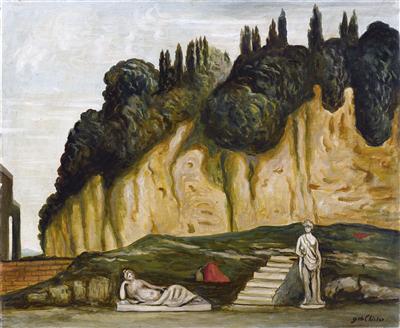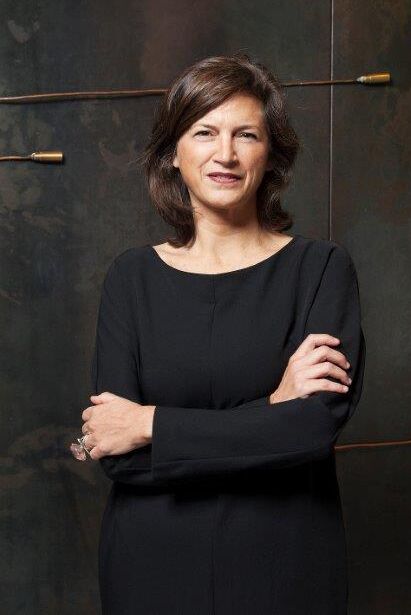Giorgio de Chirico *

(Volos, Greece, 1888–1978 Rome) Rocce misteriose, circa 1970, signed G. de Chirico, oil on canvas, 49.5 x 60 m, framed, (PP)
Photo certificate:
Claudio Bruni Sakraischik, Rome, 27 December 1985, archive no. 127/85
Provenance:
Private Collection, Europe
The work here, Rocce Misteriose, by Giorgio De Chirico is clearly influenced by the works of Arnold Böcklin, a representative of the late German Romantic.
Böcklinist elements repeatedly appear in De Chirico’s works, with the artist sometimes adopting entire scenes and motifs from Böcklin’s paintings and interpreting them in his own manner. Despite a lack of written documentation, De Chirico’s böcklinismo is associated with the originals held in Munich’s museums.
Giorgio de Chirico was born in Greece in 1888, the son of Italian parents, and spent the early years of his childhood in the country of the classics, an influence which was to remain with him throughout his entire creative life. The combining of important experiences or decisive events with gods and heroes from Greek mythology is a characteristic trait of De Chirico’s art, which is almost constantly autobiographically motivated.
As in the theatrical scenes of the work here, Rocce Misteriose (mysterious stones), we can clearly recognize the character of the Mediterranean island world, for example Pontikonisi, which was the inspiration behind Arnold Böcklin’s work Toteninsel (island of the dead). The painting depicts an impressive rocky reef, rising from the sea, draped in a cloak of dark cypresses. The artistic transformation of a real place, an important feature of Böcklinism, is continued in De Chirico’s work. Yet, De Chirico combines the “naturalistic” depiction of actual landscapes and architectural features with a mythological element: he is combining reality with mythology. In the work here too, he combines elements from various levels of reality, lending the Hellenist statues a human, almost lively character. His ability to present the unreal as normal and every day is further evidence of a deep bond between De Chirico and Böcklin.
De Chirico tries to present the concept of “interpreting nature“ as a means of combining landscape with mythology in an indirect manner, without stepping out of Böcklin’s defined boundaries of late Romantic image conception.
(Arnold Böcklin, Giorgio De Chirico, Max Ernst. Eine Reise ins Ungewisse, published by Benteli, Bern, 1997, page 204–229)
Specialist: Mag. Patricia Pálffy
 Mag. Patricia Pálffy
Mag. Patricia Pálffy
+43-1-515 60-386
patricia.palffy@dorotheum.at
28.11.2012 - 18:00
- Estimate:
-
EUR 100,000.- to EUR 150,000.-
Giorgio de Chirico *
(Volos, Greece, 1888–1978 Rome) Rocce misteriose, circa 1970, signed G. de Chirico, oil on canvas, 49.5 x 60 m, framed, (PP)
Photo certificate:
Claudio Bruni Sakraischik, Rome, 27 December 1985, archive no. 127/85
Provenance:
Private Collection, Europe
The work here, Rocce Misteriose, by Giorgio De Chirico is clearly influenced by the works of Arnold Böcklin, a representative of the late German Romantic.
Böcklinist elements repeatedly appear in De Chirico’s works, with the artist sometimes adopting entire scenes and motifs from Böcklin’s paintings and interpreting them in his own manner. Despite a lack of written documentation, De Chirico’s böcklinismo is associated with the originals held in Munich’s museums.
Giorgio de Chirico was born in Greece in 1888, the son of Italian parents, and spent the early years of his childhood in the country of the classics, an influence which was to remain with him throughout his entire creative life. The combining of important experiences or decisive events with gods and heroes from Greek mythology is a characteristic trait of De Chirico’s art, which is almost constantly autobiographically motivated.
As in the theatrical scenes of the work here, Rocce Misteriose (mysterious stones), we can clearly recognize the character of the Mediterranean island world, for example Pontikonisi, which was the inspiration behind Arnold Böcklin’s work Toteninsel (island of the dead). The painting depicts an impressive rocky reef, rising from the sea, draped in a cloak of dark cypresses. The artistic transformation of a real place, an important feature of Böcklinism, is continued in De Chirico’s work. Yet, De Chirico combines the “naturalistic” depiction of actual landscapes and architectural features with a mythological element: he is combining reality with mythology. In the work here too, he combines elements from various levels of reality, lending the Hellenist statues a human, almost lively character. His ability to present the unreal as normal and every day is further evidence of a deep bond between De Chirico and Böcklin.
De Chirico tries to present the concept of “interpreting nature“ as a means of combining landscape with mythology in an indirect manner, without stepping out of Böcklin’s defined boundaries of late Romantic image conception.
(Arnold Böcklin, Giorgio De Chirico, Max Ernst. Eine Reise ins Ungewisse, published by Benteli, Bern, 1997, page 204–229)
Specialist: Mag. Patricia Pálffy
 Mag. Patricia Pálffy
Mag. Patricia Pálffy
+43-1-515 60-386
patricia.palffy@dorotheum.at
|
Buyers hotline
Mon.-Fri.: 10.00am - 5.00pm
kundendienst@dorotheum.at +43 1 515 60 200 |
| Auction: | Modern Art |
| Auction type: | Saleroom auction |
| Date: | 28.11.2012 - 18:00 |
| Location: | Vienna | Palais Dorotheum |
| Exhibition: | 17.11. - 28.11.2012 |
